QuestionHi. I have had my 20 gallon freshwater tank for a year and I couldn't tell you how many fish have died. I have let the tank go longer than it should without cleaning it(not extremely), but I always clean the filter. I also had a population explosion with mollies, but I got rid of all the babies except for 4 of them. I had the 2 mother mollies and 3 of the babies die on Fri., so I changed 6 gallons. Today 2 little catfish and my red tail shark(who was one of the original fish) died. Now I only have 1 molly, 1 silver dollar(who is the other original fish), one algae eater and 2 guppies left. The algae eater doesn't do a very good job either, so there's excess algae growth too. I use a gravel vacuum when I change the water. I have a decent top running pump amd filter system. The tank gets whitish cloudy often also. Everything will be going good and all my fish suddenly die-this isn't the first time. I use water conditioner when I change it, and occasionaly use the clearing drops. The water readings are good(I did get high ammonia, but got it under control about 3 mths ago). Our family really does like the fish tank, but I just can't seem to get it straight and it stay that way. Thank you for helping me out-I really appreciate it that people like yourself dedicate yourselves and volunteer your expertise to help others(like me):)
AnswerHi Lisa,
What you describe is not uncommon at all. The truth is, aquariums can go wrong in all sorts of ways. It is not that difficult to get to the point where you have a low maintenance, happy aquarium - but the most important step to getting there is one word: reading!
You absolutely must read to comprehend what's going on in your tank. You may have had it running a year, but unless you got a book on freshwater aquariums and read lots of websites, likely you never understood exactly what was happening. If you don't research what you put in your tank, then chances are, the combination will not work - stocking an aquarium takes planning to get it right.
Here's where people usually go wrong, and how to make it right:
* Filtration. When you use a "cartridge" type hang-on back filter, every time you change your cartridge you toss lots of the beneficial bacteria that make your aquarium stable, into the trash. That's why it is important to have a filter that uses reusable biological media. As far as hang-on back filters go, this is the only one I know of that comes with media that you can rinse and reuse:
http://www.drsfostersmith.com/product/prod_display.cfm?pcatid=3610
However, a canister filter will almost always come with some foam pads and/or ceramic rings that function as biological media. Here's a web page that explains how filter media functions:
http://www.firsttankguide.net/filters.php
One effective, economical means of adding bio-filtration to your aquarium is to install an undergravel filter. These filters are not for everyone (they are not compatible with live plants, or fish that dig in the gravel) but they could be beneficial in your case. Go to Google.com and type "undergravel filter" to research further.
* Tank size. People often get fish that are too big for their tanks. Your silver dollar, and the usual kinds of algae eaters (be they Chinese algae eater or plecostomus) grow too large for a 20 gallon tank. Research every fish you get ahead of purchase. The information pet store employees give you may not be accurate, that's why it's important to use Google to find out about the fish for yourself.
* Water chemistry. This is a big one...let me explain with an analogy. You wouldn't plant cactus outside if you lived in a swampy wetland, and you wouldn't plant a bog tree in an arid climate with sandy soil, would you? No, because these plants require opposite conditions than what you have naturally...and while you could dig holes and amend the soil to make it dry for the cactus, or try to keep the bog trees constantly wet, it would be silly to try!
Pick fish that like the water chemistry that you have naturally. So if the water that comes out of your tap is hard, pick fish that like hard water...if the water coming out of your tap is soft, it is ESPECIALLY important not to get fish that like hard water. Fish that like soft water can often grow accustomed to harder water than they would prefer, but fish that like hard water will NEVER get used to soft water. Livebearers (such as mollies, guppies, platys and swordtails) and goldfish all hate soft water. So it is up to you to either get a water test kit (highly recommended!) or get your water tested at the fish store to determine what your: 1) pH 2) alkalinity and 3) hardness levels are, right out of your tap. This will give you an idea of the kind of fish you can keep. If you pick fish that thrive in your water chemistry, you will make your job about a hundred times easier!
* Water quality. This is another big one. Ammonia and nitrites MUST be 0 ppm for your fish to stay healthy...established, cycled, balanced tanks never register these levels at all. White or grey cloudy water is indicative of a bacterial bloom and almost always corresponds with high ammonia and/or nitrite. This will harm your fish if you do not respond swiftly with immediate water changes using dechlorinator.
Here is an article that explains all about cycling:
http://freshaquarium.about.com/cs/biologicalcycle/a/nitrogencycle.htm
Even though it is aimed at explaining how a brand new aquarium works, it is relevant to you even with your established aquarium, because something is throwing your nitrogen cycle off balance.
The things that tend to do this are:
* Lack of (or interruption of) biological filtration
* Overfeeding
* Overstocking
* Not changing enough water (you must change at least 50% 2x monthly, but 30-40% weekly is best)
Review how much you are feeding the fish, because it is not uncommon for people to overfeed. One pinch of flakes or pellets the size of your pinky nail is plenty of food to keep your fish nourished for the day. You can feed them this much twice a day. All of the food should be gone in less than a minute, there shouldn't be any reaching the gravel - it will just sit there and rot! Your catfish might eat a little of it, but they ought to be getting their own pellet foods.
I bet that your filter doesn't have sufficient biological media. This is often the case with those filters that come included with a kit. You might also have been overstocked, and maybe overfed. Not changing the water weekly will often cause a tank with low alkalinity to crash, that's why it is so important to test your water chemistry. Alkalinity buffers pH, and if the pH plummets, the fish are distressed.
I could go on, there's so much to cover...but I'm sure I've already overwhelmed you! This is why a book is so helpful. You just put it down and continue when you are able; read little chunks or chapters a bit at a time. Just step back and look at the big picture. You already know you're doing *something* wrong. I gave you clues, now you have to do some detective work to figure out what the somethings are! Here are some websites to help:
http://www.firsttankguide.net
http://freshaquarium.about.com
http://badmanstropicalfish.com
http://www.wetwebmedia.com
Bookmark those websites and come back to them. A handful of websites can help you a whole bunch, but a book is one stop shopping, so I highly recommend you go to the public library and check out their books on freshwater aquariums. Before buying an aquarium book at a bookstore, make sure it is loaded with facts and step-by-step instructions, not just lots of glossy pictures.
That's my advice, I hope that helps! Take care.
Nicole

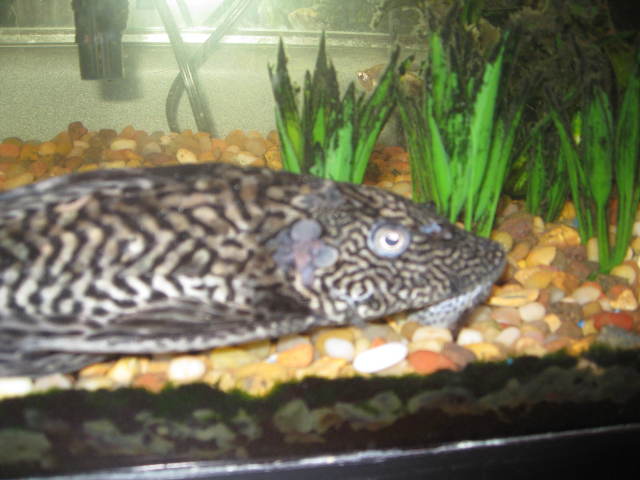 Pleco with bubbly growth
QuestionQUESTION: Im not a real fish person, but I have
Pleco with bubbly growth
QuestionQUESTION: Im not a real fish person, but I have
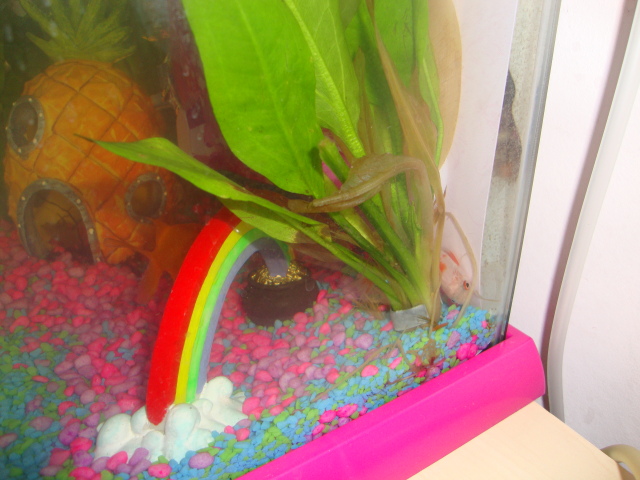 goldfish behaviour
Question
white fish
hi
i have had a small 18l tank now
goldfish behaviour
Question
white fish
hi
i have had a small 18l tank now
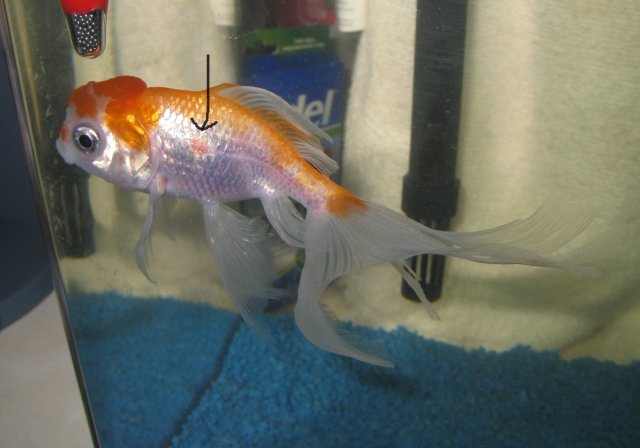 4 yr goldfish red spot
QuestionMy Goldfish
QUESTION: My goldfish sudden
4 yr goldfish red spot
QuestionMy Goldfish
QUESTION: My goldfish sudden
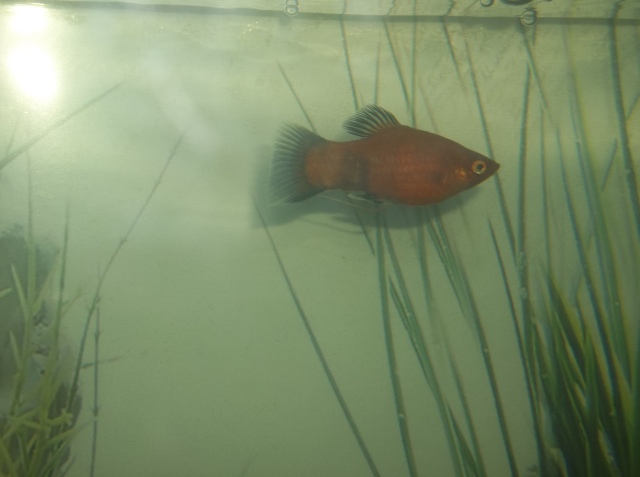 RED WAG PLATY SICK?
QuestionQUESTION: I HAVE A 60 GAL TANK WITH BRACKISH WA
RED WAG PLATY SICK?
QuestionQUESTION: I HAVE A 60 GAL TANK WITH BRACKISH WA
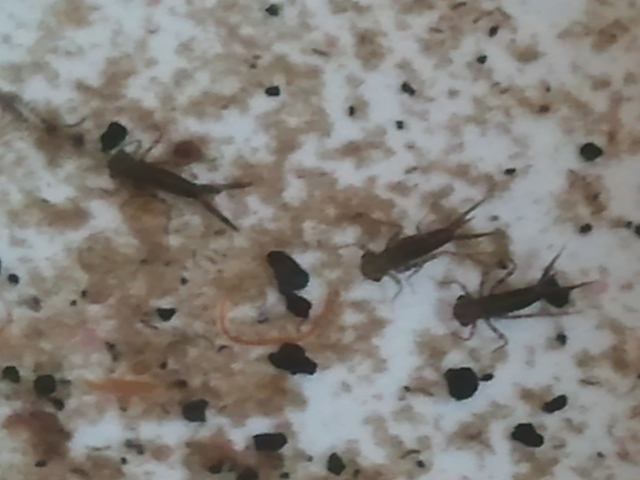 Found brown bugs in my filter!
Question
Bugs in tank
I cant find this answer an
Found brown bugs in my filter!
Question
Bugs in tank
I cant find this answer an